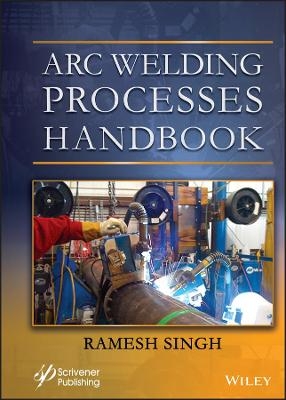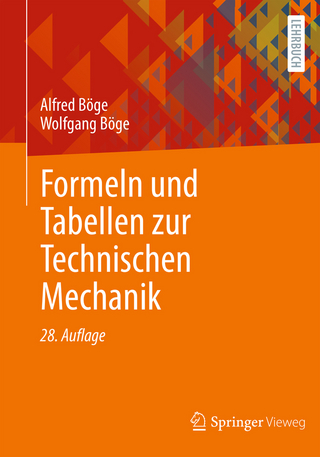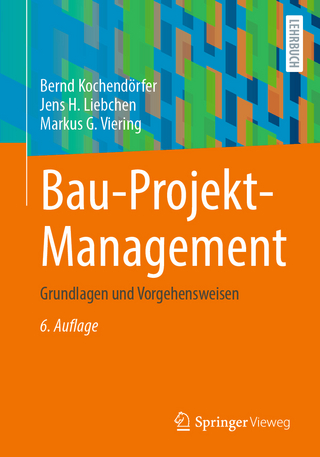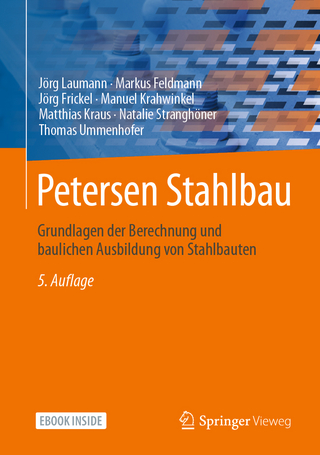
Arc Welding Processes Handbook
Wiley-Scrivener (Verlag)
978-1-119-81905-9 (ISBN)
Written by a welding/metallurgical engineer with over 40 years of experience, Arc Welding Processes Handbook delivers the welding and materials expertise required to master complex welding processes and techniques to ensure that the task is done correctly and safely, while reinforcing an understanding of international welding standards and rules.
The perfect handbook for those professionals who need an up-to-date reference to advance processes as well as those welders new to the field and need to hone their skills. Arc Welding Processes Handbook five-part treatment starts with a clear and rigorous exposition of the applications and equipment of Shielded Metal Arc Welding (SMAW) and Gas Tungsten Arc Welding (GTAW), followed by self-contained parts concerning processes applications and equipment for Gas Metal Arc Welding (GMAW), Flux Core Arc Welding (FCAW), and Submerged Arc welding (SAW).
An applied reference, each Part of Arc Welding Processes Handbook offers valuable information regarding the industry or industries where the process is commonly used as well as a description of the equipment. In addition, this Handbook discusses the challenges presented by a number of corrosion-resistant alloys (CRAs). Case studies are included throughout the reference to reinforce an understanding of how these processes were applied in the field and how they intersect with issues that may arise with equipment use and materials.
The reader will also find in the Handbook:
Highlights the key advantages and limitations of each process and suggests an alternate approach to overcome those limitations
One-of-a-kind case studies to reinforce an understanding of international welding standards and rules.
Quality of welds, type of equipment, materials, and inspection and testing for each process.
Metal joining processes like soldering and brazing.
Audience
The intended market for this book is professionals working in shipbuilding, construction of buildings, bridges, and other structures and to join pipes in pipelines, power plants, manufacturing, and repair.
Ramesh Singh, MS, IEng, MWeldI, is registered as Incorporated Engineer with the British Engineering Council UK and a Member of The Welding Institute, UK. He worked as an engineer for various operating and EPC organizations in the Middle East, Canada, and the US. Most recently, he worked for 10 years with Gulf Interstate Engineering, Houston, TX. He is now consulting in the fields of welding, and corrosion engineering, and pipeline integrity and related materials and corrosion topics. Ramesh is a graduate of the Indian Air Force Technical Academy, with diplomas in Structural Fabrication Engineering and Welding Technology. He has been a member and officer of the Canadian Standard Association and NACE and serves on several technical committees. He has worked in industries spanning aeronautical, alloy steel castings, fabrication, machining, welding engineering, petrochemical, and oil and gas. He has written several technical papers and published articles in leading industry magazines, addressing the practical aspects of welding, construction, and corrosion issues relating to structures, equipment, and pipelines.
List of Figures xvii
List of Tables xxv
Foreword xxix
Preface xxxi
1 Introduction to Welding Processes 1
1.1 Synopsis 1
1.2 Keywords 1
1.3 Welding 1
1.4 Defining Welding 2
1.5 Welding and Joining Processes 3
1.6 Arc Welding 3
1.6.1 Carbon Arc Welding 3
1.6.2 Shielded Metal Arc Welding (SMAW) 3
1.6.3 Gas Tungsten Arc Welding (GTAW) 4
1.6.4 Gas Metal Arc Welding (GMAW) 7
1.6.5 Submerged Arc Welding (SAW) 7
1.7 Efficiency of Energy Use 7
1.8 Welding Procedures 8
1.9 Qualification of Welders and Operators 11
2 Shielded Metal Arc Welding (SMAW) 13
2.1 Synopsis 13
2.2 Keywords 13
2.3 Introduction 13
2.4 Process Fundamentals 14
2.5 How the Process Works 15
2.6 Power Sources 16
2.6.1 Constant Current and Constant Voltage Power Source 17
2.6.2 Constant Current Curve 18
2.6.3 Constant Voltage Curve 18
2.7 AC Power Sources 18
2.7.1 The Alternator Type AC Welding Machines 19
2.7.2 Movable Coil Type Control 20
2.7.3 Movable Shunt Type Control 20
2.7.4 Movable Core (Reactor) Type of Control 20
2.7.5 Magnetic Amplifier Method of Current Control 21
2.7.6 Diode 22
2.7.7 Silicon-Controlled Rectifiers (SCRs) 23
2.7.8 Transistors 24
2.8 Direct Current Power Sources 24
2.8.1 Generator 26
2.8.2 Alternator 27
2.8.2.1 Power Source Remote Control 29
2.8.3 Installation of Welding Machines 29
2.8.3.1 Cooling System for Welding Power Sources 30
2.8.3.2 Welding Connections – Welding Cable and Electrode Holders 30
2.8.4 Electrode Holders 31
2.8.5 Arc Welding Power Source Classification by NEMA 32
2.8.5.1 Duty Cycle 33
2.8.5.2 Power Requirement 34
2.9 Welding Safety and Personal Protecting Equipment 34
2.9.1 Shields and Helmets 34
2.9.2 Optical Clarity for Welding 37
2.9.3 Other Essential Clothing for Welders 38
2.10 Covered Electrodes Used in SMAW Process 39
2.10.1 Coating Types 39
2.10.1.1 Cellulose-Coated Electrodes 40
2.10.1.2 Rutile-Coated Electrodes 40
2.10.1.3 Basic-Coated Electrodes 40
2.10.2 Portfolio of SMAW Electrode 41
2.10.3 Identification of Welding Electrode 41
2.10.4 Need for the Covered Electrode 45
2.10.5 Electrode Conditioning 45
2.11 Welding Training – Making of a Welder 47
2.11.1 Joint Design and Preparation 47
2.11.2 SMAW Welding of Plate 50
2.11.3 Making of a SMAW Welder 50
2.11.3.1 SMAW Welding Practice Step 1 51
2.11.3.2 SMAW Welding Practice Step 2 52
2.11.3.3 SMAW Welding Practice Step 3 56
2.11.4 Inspection of the Weld 57
2.11.4.1 Appearance of the Weld 57
2.11.5 Step 3 Practice 2 59
2.11.6 SMAW Welding Step 4 59
2.11.7 SMAW Welding Step 5 60
2.11.8 Set a Next Goal to Achieve 61
2.11.9 SMAW Welding of Pipes 62
2.11.9.1 Pipe Welding Step 1 62
2.11.10 Pipe Welding Technique and Pipeline Welding 67
2.11.10.1 Vertical Up Technique 69
2.11.11 In-Plant Piping 70
2.11.12 Pipeline Welding 72
2.11.12.1 Making a Root Pass 72
2.12 Welding Other Metals 74
2.12.1 SMAW Welding Aluminum 74
2.12.2 Aluminum Alloys and Their Characteristics 75
2.12.2.1 1xxx Series Alloys 75
2.12.2.2 2xxx Series Alloys 75
2.12.2.3 3xxx Series Alloys 75
2.12.2.4 4xxx Series Alloys 76
2.12.2.5 5xxx Series Alloys 76
2.12.2.6 6XXX Series Alloys 76
2.12.2.7 7XXX Series Alloys 77
2.12.3 The Aluminum Alloy Temper and Designation System 77
2.12.4 Wrought Alloy Designation System 78
2.12.5 Cast Alloy Designation 78
2.12.6 The Aluminum Temper Designation System 80
2.12.6.1 Aluminum Welding Electrodes 82
2.12.6.2 Electrical Parameters 83
2.12.7 SMAW Welding of Stainless Steel 83
2.12.8 Introduction to Stainless-Steels 84
2.12.8.1 Cutting Stainless Steel for Fabrication 84
2.12.8.2 Finishing 84
2.12.9 Fabrication of Stainless Steel 85
2.12.9.1 Why Use Stainless Steel 85
2.12.10 General Welding Characteristics 85
2.12.10.1 Protection Against Oxidation 86
2.12.11 Welding and Joining Stainless Steel 87
2.12.12 Importance of Cleaning Before and After Welding 87
2.12.13 Filler Metals 88
2.12.14 Austenitic Stainless Steels 89
2.12.14.1 Metallurgical Concerns Associated with Welding Austenitic Stainless Steels 89
2.12.14.2 Mechanical Properties of Stainless Steels 89
2.12.15 Welding of Austenitic Stainless Steels 90
2.12.16 Super-Austenitic Stainless Steels 91
2.12.17 Welding and Joining of Supper-Austenitic Stainless Steels 92
2.12.17.1 Difficulties Associated with Welding Stainless Steel 93
2.12.18 Martensitic Stainless Steels 96
2.12.18.1 Properties and Application 96
2.12.18.2 Welding Martensitic Stainless Steels 97
2.12.19 Welding Ferritic Stainless Steels 98
2.12.19.1 Properties and Application 98
2.12.20 Welding Ferritic Steel 99
2.12.21 Precipitation Hardening (PH) Stainless Steels 100
2.12.21.1 Properties and Application of Precipitation Hardening Steels 100
2.12.22 Welding Precipitation Hardened (PH) Steels 100
2.13 Welding and Fabrication of Duplex Stainless Steels 103
2.13.1 Mechanical Properties 103
2.13.2 Heat Treatment 104
2.14 SMAW Welding Nickel Alloys 106
2.14.1 Welding of Precipitation Hardenable Nickel Alloy 109
2.14.2 Welding of Cast Nickel Alloy 110
2.14.3 Nickel – Chromium Alloys 110
2.14.4 Nickel – Copper (Cupro-Nickle Alloys) 111
2.14.5 Nickel – Iron – Chromium Alloys 111
2.15 Minimizing Discontinuities in Nickel and Alloys Welds 112
2.15.1 Porosity 112
2.15.2 Weld Cracking 113
2.15.3 Stress Corrosion Cracking 113
2.15.4 Effect of Slag on Weld Metal 113
2.16 Review Your Knowledge 114
3 Gas Tungsten Arc Welding 115
3.1 Synopsis 115
3.2 Keywords 115
3.3 Introduction to Gas Tungsten Arc Welding Process 115
3.4 Process Description 117
3.5 How the Process Works 118
3.6 Process Advantages and Limitations 120
3.7 Power Sources 122
3.7.1 AC Power Sources 122
3.7.1.1 The Alternator Type AC Welding Machines 124
3.7.1.2 Movable Coil Movable Core (Reactor) 124
3.7.1.3 Magnetic Amplifier Method of Current Control 125
3.7.1.4 AC Inverters for GTAW Process 125
3.7.2 Other Control Methods 126
3.7.2.1 Wave Forms 126
3.7.2.2 Independent Amperage Control 127
3.7.2.3 Adjustable AC Output Frequency 127
3.7.2.4 Extended Balance Control 130
3.7.3 Diode 132
3.7.4 Silicon-Controlled Rectifiers (SCRs) 132
3.7.5 Transistors 133
3.7.6 A Direct Current Power Source for GTAW 134
3.7.6.1 Generator 134
3.7.6.2 Alternator 136
3.7.6.3 The Output Current 137
3.7.6.4 Duty Cycle 137
3.7.7 The Inverter Machines 138
3.8 Shielding Gases 138
3.9 Gas Regulators and Flowmeters 139
3.10 GTAW Torches, Nozzles, Collets, and Gas Lenses 141
3.10.1 Gas Lens 142
3.11 Tungsten Electrodes 145
3.11.1 Grinding of Tungsten Electrode Tips 146
3.11.2 Tungsten Grind Angles and How They Affect Weld Penetration 148
3.11.2.1 The Impact of Tungsten Tip Angles on Weld 148
3.12 Joint Design 149
3.13 Power Source Remote Control 151
3.14 Installation of Welding Machines 151
3.15 Power Source Cooling System 151
3.16 Welding Connections – Welding Cable and Welding Torch Connections 152
3.17 Welding Power Source Classification by NEMA 154
3.18 Welding Personal Protecting Equipment 155
3.19 Other Essential Clothing for Welders 156
3.20 Filler Wires Used in GTAW Process 156
3.21 Classification and Identification of Welding Wires 157
3.21.1 Designation of Aluminum Welding Wires 157
3.21.2 Aluminum Alloys and Their Characteristics 158
3.22 The Aluminum Alloy Temper and Designation System 161
3.22.1 Wrought Alloy Designation System 161
3.22.2 Cast Alloy Designation 162
3.22.3 The Aluminum Temper Designation System 162
3.23 Welding Metals Other Than Carbon and Alloy Steels 164
3.24 GTAW Welding of Aluminum 165
3.25 GTAW Welding of Stainless Steel 176
3.25.1 Introduction to Stainless-Steels 176
3.25.1.1 Cutting Stainless Steel for Fabrication 177
3.25.1.2 Finishing 177
3.25.2 Fabrication of Stainless Steel 178
3.25.3 Why Stainless Steel 178
3.25.4 General Welding Characteristics 179
3.25.5 Protection Against Oxidation 179
3.25.6 Welding and Joining 180
3.25.7 Importance of Cleaning Before and After Welding 180
3.25.8 Filler Metals 182
3.25.9 Austenitic Stainless Steels 182
3.25.9.1 Metallurgical Concerns Associated with Welding Austenitic Stainless Steels 182
3.25.9.2 Mechanical Properties of Stainless Steels 183
3.25.9.3 Welding of Austenitic Stainless Steels 183
3.25.10 Welding Super-Austenitic Stainless Steels 185
3.25.10.1 Material Properties and Applications 185
3.25.10.2 Welding and Joining of Supper-Austenitic Stainless Steels 188
3.25.10.3 Difficulties Associated with Welding Stainless Steel 189
3.25.11 Welding Martensitic Stainless Steels - Properties and Application 190
3.25.12 Welding Martensitic Stainless Steels 191
3.25.13 Welding Ferritic Stainless Steels 192
3.25.13.1 Welding Ferritic Steel 193
3.25.14 Welding Precipitation Hardening Stainless Steels 193
3.25.14.1 Welding Precipitation Hardened (PH) Steels 194
3.26 Mechanical Properties 195
3.26.1 Heat Treatment of Duplex Steels 195
3.26.2 How to Weld Duplex Stainless Steel 197
3.26.2.1 Filler Metal 197
3.26.2.2 Heat Input and Interpass Temperatures 198
3.26.2.3 Quality Checks 198
3.27 Welding Nickel Alloys 198
3.27.1 Welding of Precipitation Hardenable Nickel Alloy 200
3.27.2 Welding of Cast Nickel Alloy 200
3.27.3 Nickel – Chromium Alloys 200
3.27.4 Nickel – Copper (Cupro-Nickle Alloys) 201
3.27.5 Nickel – Iron – Chromium Alloys 202
3.27.6 Minimizing Discontinuities in Nickel and Alloys Welds 202
3.27.6.1 Porosity 203
3.27.6.2 Weld Cracking 203
3.27.6.3 Stress Corrosion Cracking 203
3.27.6.4 Effect of Inclusions on Weld Metal 204
3.28 Later Developments in GTAW Process 204
3.29 Plasma Arc Welding 204
3.30 Review Your Knowledge 207
4 Gas Metal Arc Welding 209
4.1 Synopsis 209
4.2 Keywords 209
4.3 Introduction to Gas Metal Arc Welding Process 209
4.3.1 Developmental History of GMAW Process 209
4.3.2 The Advantages of GMAW 213
4.3.2 Limitations of GMAW 213
4.4 Process Description 214
4.4.1 Gas Metal Arc Welding (GMAW) Process Introduction 214
4.4.1.1 Short Circuiting Transfer (GMAW-S) 217
4.4.1.2 Globular Transfer 221
4.4.1.3 Spray Transfer 223
4.4.1.4 Pulsed Spray Transfer Mode 224
4.4.2 Gas Metal Arc Welding: Newer Variants 229
4.5 Components of the Welding Arc 231
4.5.1 Shielding Gases for GMAW 232
4.5.1.1 Argon Gas 233
4.5.1.2 Helium Gas 234
4.5.2 Dissociation and Recombination 234
4.5.2.1 Dissociation and Recombination of CO2 Gas 234
4.5.2.2 Oxygen as Shielding Gas 234
4.5.2.3 Hydrogen Gas 235
4.5.3 Binary Shielding Gases 235
4.5.3.1 Argon + Helium 235
4.5.3.2 Argon + CO2 235
4.5.4 Shielding Gases by Transfer Mode 236
4.5.4.1 Common Short-Circuiting Transfer 236
4.5.4.2 Common Axial Spray Transfer 236
4.5.5 Ternary Gas Shielding Blends 237
4.5.5.1 Common Ternary Gas Shielding Blends 237
4.6 Effects of Variables on Welding 238
4.6.1 Current Density 241
4.6.2 Electrode Efficiencies 241
4.6.2.1 Calculation of Required Electrode Based on the Electrode Efficiency (EE) 242
4.6.3 Deposition Rate 242
4.6.4 Electrode Extension and Contact Tip to Work Distance 243
4.7 Advanced Welding Processes for GMAW 244
4.8 The Adaptive Loop 245
4.9 Advanced Waveform Control Technology 246
4.9.1 Surface Tension Transfer™ (STT™) 246
4.10 Equipment for GMAW Process 248
4.11 GMAW Power Sources 249
4.11.1 The Transformer Rectifiers 249
4.11.2 Inverters 250
4.12 Installation of Welding Machines 253
4.12.1 GMAW Torches 254
4.12.1.1 Welding Torches for Automation and Robotic GMAW 257
4.12.1.2 The Wire Drive and Accessories 257
4.12.1.3 Special Wire Feeding Considerations 258
4.12.1.4 Shielding Gas Regulation 259
4.12.1.5 Welding Cables and Other Accessories 259
4.12.1.6 Welding Personal Protecting Equipment 261
4.12.1.7 Other Essential Clothing for Welders 262
4.13 Welding Various Metals 262
4.13.1 Carbon Steel 263
4.13.2 Aluminum and Aluminum Welding 263
4.13.2.1 Understanding Aluminum 263
4.13.2.2 Designation of Aluminum Welding Wires 264
4.13.3 Aluminum Metallurgy and Grades 265
4.13.3.1 1xxx Series Alloys 265
4.13.3.2 2xxx Series Alloys 265
4.13.3.3 3xxx Series Alloys 266
4.13.3.4 4xxx Series Alloys 266
4.13.3.5 5xxx Series Alloys 266
4.13.3.6 6XXX Series Alloys 267
4.13.3.7 7XXX Series Alloys 267
4.13.4 The Aluminum Alloy Temper and Designation System 267
4.13.5 Wrought Alloy Designation System 268
4.13.6 Cast Alloy Designation 268
4.13.7 The Aluminum Temper Designation System 269
4.13.8 Welding Aluminum 271
4.13.8.1 Electrode Selection 271
4.13.9 Welding Stainless Steel with the Gas Metal Arc Process 271
4.13.10 Introduction to and Understanding Stainless Steel 274
4.13.11 Alloying Elements and Their Impact on Stainless Steel 275
4.13.11.1 The Elements that Promote Ferrite are 276
4.13.11.2 The Elements that Promote Austenite are 276
4.13.11.3 Neutral Effect Regarding Austenite & Ferrite 276
4.13.12 Weldability of Stainless Steels 276
4.13.12.1 Welding Austenitic Steels 276
4.13.12.2 Challenges of Welding Austenitic Steels 277
4.13.12.3 Sensitization 277
4.13.12.4 Intergranular Corrosion in the Heat Affected Zone Control of Carbide Precipitation 278
4.13.12.5 Hot Cracking 279
4.13.12.6 Design for Welding Stainless Steels 280
4.13.12.7 Determining and Measuring the Ferrite in Welds 281
4.13.12.8 Welding Ferritic Stainless Steels 282
4.13.12.9 Properties and Application 282
4.13.12.10 Welding Ferritic Steel 283
4.13.12.11 Precipitation Hardening Stainless Steels 283
4.13.12.12 Welding Precipitation Hardened (PH) Steels 284
4.13.12.13 Martensitic Stainless Steels 285
4.13.12.14 Properties and Application 285
4.13.12.15 Welding Martensitic Stainless Steels 285
4.13.12.16 Duplex Stainless Steels 287
4.13.12.17 Mechanical Properties 287
4.13.12.18 Heat Treatment 288
4.14 Welding Nickel Alloys 289
4.14.1 Welding of Precipitation Hardenable Nickel Alloy 291
4.14.2 Welding of Cast Nickel Alloy 291
4.14.3 Nickel – Chromium Alloys 291
4.14.4 Nickel – Copper (Cupro-Nickle Alloys) 292
4.14.5 Nickel – Iron – Chromium Alloys 293
4.15 Minimizing Discontinuities in Nickel and Alloys Welds 293
4.15.1 Porosity 294
4.15.2 Weld Cracking 294
4.15.3 Stress Corrosion Cracking 295
4.15.4 Effect of Slag on Weld Metal 295
4.16 Calculating Heat Input in Pulsed Arc GMAW 295
4.17 Review Your Knowledge 296
5 Flux Cored Arc Welding (FCAW) Process 299
5.1 Synopsis 299
5.2 Keywords 299
5.3 Introduction to Flux Cored Arc Welding (FCAW) Process 299
5.4 Process Description 301
5.4.1 Self Shielding Flux Cored Arc Welding (FCAW-S) Process 302
5.4.2 Flux Core Arc Welding (FCAW-G) Gas Shielding Process 303
5.5 Welding Wires/Electrodes 304
5.5.1 Construction of FCAW Electrodes 306
5.5.2 Sheath Thickness Variations 307
5.5.3 Important FCAW Variables 307
5.5.4 Contact Tip to Work Distance (CTWD) 307
5.5.5 Travel Angle 307
5.5.6 Single Pass Limitations 308
5.5.7 Thickness Restrictions 308
5.5.8 Charpy V-Notch Toughness Properties 308
5.5.9 Electrode Care and Packaging 308
5.6 Power Sources 310
5.6.1 Arc Voltage (Constant Voltage) 310
5.6.2 CTWD, ESO and WFS 311
5.7 Other Accessories to Power Source 313
5.7.1 Welding Cable 313
5.7.2 Semiautomatic Wire Feeders 313
5.7.3 Welding Guns 313
5.7.4 Reverse Bend Gun Tubes 313
5.7.5 Gun Angles 314
5.7.6 Polarity 314
5.8 Shielding Gases 314
5.8.1 Attributes of Shielding Gases 315
5.8.2 How Shielding Gas Works? 315
5.8.3 Properties of Shielding Gases 315
5.8.4 Limits on the Use of Inert Gases 316
5.8.5 Argon and Carbon Dioxide Gas Blends 316
5.8.6 How the Shielding Gas and Blends Affect the Mechanical Properties of the Weld Metal? 317
5.8.7 Understanding the Performance of Various FCAW-G Gases 319
5.8.7.1 Shielding Gas Cost 319
5.8.7.2 Overall Operator Appeal and Impact on Productivity 319
5.8.7.3 Typical Use of Shielding Gas 321
5.9 Welding Various Metals 321
5.9.1 Applicable Base Metals 322
5.9.2 Types of Welding Procedure Specifications (WPS) 323
5.9.3 FCAW Welding Austenitic, Ferritic Stainless Steels and Duplex Steels 323
5.9.3.1 Stainless Steel 323
5.9.3.2 Duplex Steels 324
5.9.3.3 Welding Ferritic Stainless Steels 324
5.9.3.4 Choice of Shielding Gases 324
5.9.4 FCAW Welding of Aluminum 324
5.9.5 Welding Nickel and Nickel Alloys by FCAW Process 325
5.10 Tips for Good Welding by FCAW Process 325
5.11 Test Your Knowledge 326
6 Submerged Arc Welding (SAW) 329
6.1 Synopsis 329
6.2 Keywords 329
6.3 Introduction to Submerged Arc Welding (SAW) Process 329
6.4 Operating Characteristics 333
6.5 Submerged Arc Welding (SAW) Process 334
6.5.1 Advantages and Limitations of Submerged Arc Welding 334
6.6 How the SAW Process Works 335
6.6.1 Depositing a Root Pass with SAW Process 335
6.6.2 Travel Mechanism 335
6.6.3 Variables of the SAW Process 336
6.7 SAW Process Variants 337
6.7.1 Variants Based on Use of Welding Wire 338
6.7.1.1 Multi-Wire Systems 338
6.7.1.2 Use of Hot-Wire 338
6.7.2 Adding Iron Powder to the Flux 339
6.7.3 The Utilization of a Strip Electrode for Surfacing 340
6.8 SAW Power Source and Equipment 340
6.9 Welding Heads (Gun) 340
6.10 Fluxes 341
6.10.1 Types of Granular Fluxes 341
6.10.2 Fused Fluxes versus Bonded Fluxes 342
6.10.3 Fused Fluxes 342
6.10.4 Bonded Fluxes 342
6.10.5 Neutral Fluxes 343
6.10.6 Acid Fluxes 343
6.10.7 Basic Fluxes 343
6.10.8 Selection of Specific Flux 345
6.11 Submerged Arc Welding Various Metals 345
6.12 Test Your Knowledge 347
7 Useful Data and Information Related to Welding and Fabrication 349
7.1 Common Weld Symbols and Their Meanings 349
7.2 Fillet Welds 351
7.3 Groove Welds 353
7.4 Pipe Schedule 359
7.5 Terms and Abbreviations 360
7.5.1 ASME Section IX QW 432 - F Number Table for Carbon and Alloy Steel 363
7.6 Procedure Qualification Range as Per the Material Group 364
7.7 Material Qualification Rage for Procedure Qualification Based on P-Numbers 364
7.8 Temperature Conversion 365
7.9 Useful Calculations 367
7.10 Effect of Temperature on Gas Cylinder Pressure 368
Index 369
| Erscheinungsdatum | 05.11.2021 |
|---|---|
| Sprache | englisch |
| Maße | 10 x 10 mm |
| Gewicht | 454 g |
| Themenwelt | Technik ► Bauwesen |
| Technik ► Maschinenbau | |
| ISBN-10 | 1-119-81905-9 / 1119819059 |
| ISBN-13 | 978-1-119-81905-9 / 9781119819059 |
| Zustand | Neuware |
| Informationen gemäß Produktsicherheitsverordnung (GPSR) | |
| Haben Sie eine Frage zum Produkt? |
aus dem Bereich


